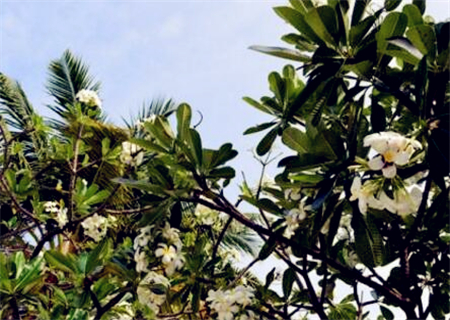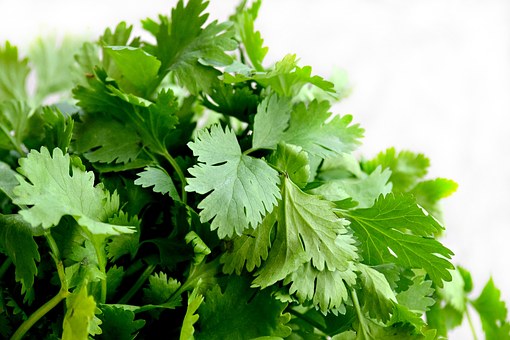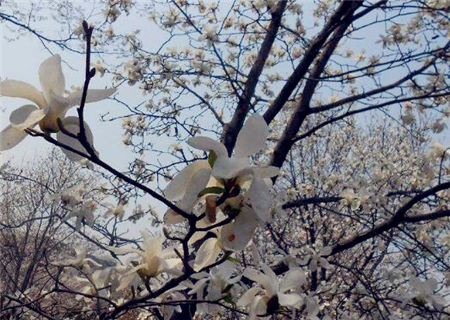When does the "bamboo peach" egg blossom tree blossom? How to plant it? How many years will it blossom and bear fruit?
Frangipani trees are cultivated in Guangdong, Guangxi, Yunnan, Fujian and other provinces in China, and some of them are wild in the mountains of southern Yunnan. So when does the egg flower tree blossom? How to plant it? How many years will it blossom and bear fruit? The details are as follows:

When does the egg flower tree blossom?
The frangipani blossoms in August and September every year.
How to plant frangipani trees
Egg flowers like hot and humid climate, resistant to drought, born in limestone, cutting propagation is very easy to survive. Generally appropriate in late May, cut from the base of the branch 20-30 cm long, white milk flow out of the cut, need to be placed in a cool ventilated place for 2-3 days, so that the wound formed a protective film and then cutting, cutting with milk is easy to rot. Insert it into a clean vermiculite or sand bed or shallow sand basin, then spray water under the indoor or outdoor shade, spray water every other day to keep the matrix moist. 15-20 days after cutting moved to semi-shade, so that it can see weak light, 30-35 days to take root, 45 days on the basin, cutting seedlings to survive, in time to transplant in the diameter of 20 cm pot, egg flowers on the soil requirements are not strict, should be planted in the loose soil containing more humus, planting can be slightly exposed roots on the pot, set up indoor after planting, a week later to see weak light, and then half a month can be placed in a sunny place. Egg blossom grows rapidly and needs to be changed once every spring, generally into a 30cm flowerpot. The pot soil can be mixed with 4 parts of garden soil, 4 parts of horse dung soil and 2 parts of river sand, with 100 grams of cake fertilizer or sauce dregs and 50 grams of superphosphate or bone powder in each basin. After the pot was changed and planted, Grain Rain was watered thoroughly, and the front and rear of the plant was moved to the outdoor sunny place. Egg flowers like warm, moist, sunny growth environment, summer does not need shade, can be placed in outdoor exposure. Summer and autumn are egg flower growth, flowering period, watering 1-2 times every night, summer and autumn rain, should be timely poured out of the basin stagnant water. From June to November, the rotten liquid fertilizer was applied every 10 days or so, and the concentration was 15%. The southern egg blossom is planted in the open field, the leaves fall in winter, and the new leaves are regenerated the following spring. The potted plants in the north should move into the indoor south window in the middle and late October and pay attention to ventilation and visible light. The room temperature should be more than 10 ℃, low temperature and poor indoor ventilation will make the plants lose leaves, and indoor watering should be watered every two weeks.
Potted egg flowers should use clay pots with good permeability, such as plastic pots to put layers of broken bricks and tiles or hard plastic foam blocks at the bottom of the pot to enhance air permeability and drainage. Its root system is more developed and grows faster, and the seedlings can be planted in the middle basin with an inner diameter of 20 cm. As the plant grows, it can be replaced into a larger basin. It is not very strict on the soil, so it grows best in loose and fertile sandy loam. Family potted plants can use rotten leaf soil and vegetable garden topsoil to mix with a small amount of sand, and turn the basin before sprouting every spring to change soil.
Egg blossoms like to be wet and resistant to drought, but they are afraid of waterlogging. Therefore, watering should be moderate, grasp the principle of no dry, no watering, no watering, no waterlogging. In the spring and autumn interval, the soil is watered once every day from 1 to 2 days, once in the morning on a sunny day in summer, and once again in the evening if the soil is dry. In the rainy season, attention should be paid to pouring the stagnant water in the basin to prevent rotting roots, and once every ten days and a half months in winter to keep the basin soil slightly moist and dry. It likes fertilizer, it is appropriate to add 20 grams to 30 grams of bone powder and 50 grams to 80 grams of superphosphate (because it is born in calcareous soil, pay attention to calcium supplement), from May to October, 10 to 15 days to apply a thin mature organic fertilizer or nitrogen, phosphorus and potassium compound fertilizer, avoid single application of nitrogen fertilizer, prevent apprentice growth, and do not apply fertilizer in winter.
Egg flower is a strong positive flower, the more sunshine, the more luxuriant growth, more flowers and fragrance, except on the pot or turn the pot to change soil after the need to shade for 7 to 10 days, the rest of the time should be placed in a sunny place. Because of its origin in tropical America, it is not cold-tolerant, and its cold tolerance is poor when it is cultivated in temperate zone in winter, so it is suitable to enter the house to survive the winter. Before the lowest temperature drops to 10 ℃, move indoors, place in a sunny place, keep room temperature 10 ℃ to 15 ℃, keep away from TV radiation and air conditioning, warm wind will not lose leaves, but if less than 8 ℃ or poor ventilation, leaves will also fall, as long as you keep more than 5 ℃, you will not freeze to death, and leaves will sprout in the next spring.
Egg flowers are planted in temperate zones and generally do not bear seeds and are propagated by cuttings. From late May to early June, branches with a length of about 20 cm are cut from the branches as cuttings, and white milk will flow out from the cuttings. if they are not treated, the cuttings will rot easily, and they can be placed in a cool place with good ventilation. 2 to 3 days later, the wound can be replanted with a protective film from the wound director, or dipped in plant ash or sulfur powder, and then inserted into vermiculite or plain sand basin after a little drying, and placed in a well-ventilated shade. Often spray water to moisturize the cuttings, move to the half-shaded place where the sun can be seen in the morning or evening after 20 days, and take root in 30 to 40 days, with a high survival rate and pots in autumn or the following spring.
Time: 2019-04-10 Click:
- Prev

When will the coriander seeds of Umbelliferae be planted? How long will it take to sprout? How do you plant it?
Coriander is a common vegetable in daily life. It is widely used as seasoning because of its special aroma. At present, it is grown in many areas, but if you want to grow cilantro well, you need to know the planting time and technology.
- Next

When will the Magnolia tree "famous flowers and trees in China" bloom? What's the best way to raise it? How much is one?
Magnolia Magnolia is a variety of magnolia with white flowers, a famous flower and tree in China, and an important ornamental tree in early spring in the north. The cultivation is very popular in Fujian, Guangdong, Guangxi, Yunnan and other provinces in China, and the provinces and regions in the Yangtze River Basin. So when does Magnolia blossom? What's the best way to raise trees? How much is it per tree?
Related
- Fuxing push coffee new agricultural production and marketing class: lack of small-scale processing plants
- Jujube rice field leisure farm deep ploughing Yilan for five years to create a space for organic food and play
- Nongyu Farm-A trial of organic papaya for brave women with advanced technology
- Four points for attention in the prevention and control of diseases and insect pests of edible fungi
- How to add nutrient solution to Edible Fungi
- Is there any good way to control edible fungus mites?
- Open Inoculation Technology of Edible Fungi
- Is there any clever way to use fertilizer for edible fungus in winter?
- What agents are used to kill the pathogens of edible fungi in the mushroom shed?
- Rapid drying of Edible Fungi

